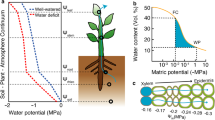Summary
Mature leaves of Mimosa pudica L. or parts of them were exposed to 14CO2, and translocation was recorded by macroautoradiography. It was observed that considerable amounts of labelled photoassimilates were accumulated in pulvini when the leaf was stimulated. In non-stimulated leaves, no such accumulation of label was observed.
Microautoradiographs of pulvinar regions of the non-stimulated leaf showed 14C- label restricted to the phloem. When stimulated, the 14C- label was unloaded from the phloem of the pulvini. Labelled photoassimilates appeared most concentrated in the walls of the collenchymatous cells and beyond in the extensor region of the motor cortex. There, label was accumulated in the apoplastic compartments. Stimulation causes a sudden phloem unloading of sucrose, and its accumulation in the apoplast lowers the water potential which eventually exceeds the osmotic potential of the extensor cells of the motor cortex. By removal of cytoplasmic water the motor cells lose turgidity which results in the closing movement of the leaflets, and — some seconds later — in the bending down of the petiole. In late afternoon night-stimulation triggers sucrose unloading in secondary pulvini. During phases of relaxation, labelled material is taken up by motor cells of the extensor, which concomitantly gain turgor.
Similar content being viewed by others
References
Allen RD (1969) Mechanism of the seismonastic reaction in Mimosa pudica. Plant Physiol 44: 1101–1107
Blechschmidt-Schneider S, Eschrich W (1985) Microautoradiographic localization of imported 14C-photosynthate in induced sink leaves of two dicotyledonous C4 plants in relation to phloem unloading. Planta 163: 439–447
Bose JC (1926) The nervous mechanism in plants. Longman, London
Brücke E von (1848) Über die Bewegungen der Mimosa pudica. Müllers Arch Anat Physiol (Leipzig). p 443
Bünning E, Tazawa M (1957) Über den Temperatureinfluß auf die endogene Tagesrhythmik bei Phaseolus. Planta 50: 107–121
Campbell NA, Garber RC (1980) Vacuolar reorganization in the motor cells of Albizzia during leaf movement. Planta 148:251–255
Campbell NA, Satter RL, Garber RC (1981) Apoplastic transport of ions in the motor organ of Samanea. Proc Natl Acad Sci USA 78: 2981–2984
Esau K (1970) On the phloem of Mimosa pudica L. Ann Bot 34: 505–515
Eschrich W (1966) Translokation 14C-markierter Assimilate im Licht und im Dunkeln bei Vicia faba. Planta 70: 99–124
Fleurat-Lessard P, Bonnemain JL (1978) Structural and ultra-structural characteristics of the vascular apparatus of the sensitive plant (Mimosa pudica L.) Protoplasma 94: 127–143
Fondeville JC, Borthwick HA, Hendricks SB (1966) Leaflet movement of Mimosa pudica L. Indicative of phytochrome action. Planta 69: 357–364
Fritz E (1980) Microautoradiographic localization of assimilates in phloem: problems and new method. In: Eschrich W, Lorenzen H (eds.) Phloem Loading and Related Processes. Fischer, Stuttgart New York, pp 109–121
Gardiner W (1888) On the power of contractility exhibited by the protoplasm of certain plant cells. Ann Bot 1: 362
Haberlandt G (1890) Das reizleitende Gewebesystem der Sinnpflanze. Eine anatomisch-physiologische Untersuchung. Engelmann, Leipzig
Houwink AL (1935) The conduction of excitation in Mimosa pudica. Rec Trav Bot Neerl 32: 51–91
Kiyosawa K (1979) Unequal distribution of potassium and anions within the Phaseolus pulvinus during circadian leaf movement. Plant Cell Physiol 20: 1621–1634
Lyubimova MN, Demyanovskaya NS, Fedorovich IB, Homlenskite IV (1964) Participation of ATP in the motor function of the Mimosa pudica leaf. Transl Biokhimiya 29: 774–779
Pfeffer W (1873) Physiologische Untersuchungen: Mimosa pudica. Engelmann, Leipzig
Pfeffer W (1877) Osmotische Untersuchungen — Studien zur Zellmechanik. Engelmann, Leipzig
Pfeffer W (1890) Plasmahaut. II. Zur Kenntnis der Plasmahaut und der Vacuolen nebst Bemerkungen über den Aggregatzustand des Protoplasmas und über osmotische Vorgänge. Hirzel, Leipzig
Pfeffer W (1911) Der Einfluß von mechanischer Hemmung und von Belastung auf die Schlafbewegungen. Abh Sächs Akad Wiss 32: 163–295
Racusen RH, Galston AW (1977) Electrical evidence for rhythmic changes in the cotransport of sucrose and hydrogen ions in Samanea pulvini. Planta 135: 57–62
Ricca V (1916) Solution d'un probleme de physiologie: la propagation de stimulus dans la sensitive. Arch Ital Biol (Pisa) 65: 219–232
Samejima M, Sibaoka T (1980) Changes in the extracellular ion concentration in the main pulvinus of Mimosa pudica during rapid movement and recovery. Plant Cell Physiol 21: 467–479
Satter RL, Galston AW (1971) Phytochrome-controlled nyctinasty in Albizzia julibrissin: III. Interaction between an endogenous rhythm and phytochrome in control of potassium flux and leaflet movement. Plant Physiol 48: 740–746
Satter RL, Galston AW (1981) Mechanisms of control of leaf movements. Annu Rev Plant Physiol 32: 83–110
Satter RL, Geballe GT, Galston AW (1974) Potassium flux and leaf movement in Samanea saman. II. Phytochrome controlled movement. J Gen Physiol 64: 431–442
Satter RL, Schrempf M, Chaudhri J, Galston AW (1977) Phytochrome and circadian clocks in Samanea. Rhythmic redistribution of potassium and chloride within the pulvinus during long dark periods. Plant Physiol 59: 231–235
Schildknecht H, Tauscher B, Pesh-Imam W, Beltle W, Kunzelmann P, Schneider D (1978) Aminosäuren als “leaf movement factors”. Naturwissenschaften 65: 125–129
Schildknecht H (1983) Turgorine, Hormone der endogenen Tagesrhythmik höher organisierter Pflanzen —Nachweis, Isolierung, Strukturaufklärung, Synthese und Wirkung. Angew Chem 95: 689–705
Schildknecht H (1984) Turgorins —new chemical messengers for plant behavior. Endeavour 8: 113–117
Setty S, Jaffe MJ (1972) Phytochrome-controlled rapid contraction and recovery of contractile vacuoles in the motor cells of Mimosa pudica as an intracellular correlate of nyctinasty. Planta 108: 121–131
Sibaoka T (1962) Excitable cells in Mimosa. Science 137: 226
Simon E, Satter RL, Galston AW (1976) Circadian rhythmicity in excised Samanea pulvini. I. Sucrose —white light interactions. Plant Physiol 58: 417–420
Toriyama H (1955) Observational and experimental studies of sensitive plants. VI. The migration of potassium in the primary pulvinus. Cytologia 20: 367–377
Weintraub M (1952) Leaf movements in Mimosa pudica L. New Phytol 50: 357–382
Author information
Authors and Affiliations
Additional information
Part of the doctoral dissertation of Jörg Fromm supported by the Deutsche Forschungsgemeinschaft
Rights and permissions
About this article
Cite this article
Fromm, J., Eschrich, W. Transport processes in stimulated and non-stimulated leaves of Mimosa pudica . Trees 2, 7–17 (1988). https://doi.org/10.1007/BF00196974
Received:
Issue Date:
DOI: https://doi.org/10.1007/BF00196974




